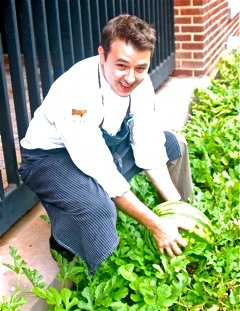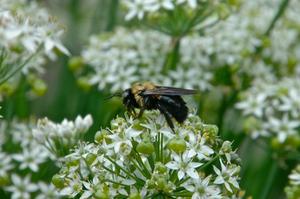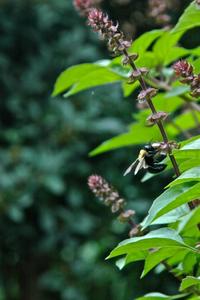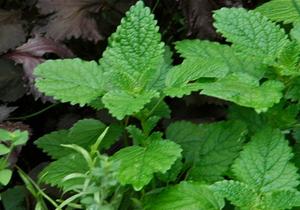Four Seasons herb garden flavors Bourbon Steak

When I was a kid, there was a drive-in, Dicks, that served the best fries. The skin was left on them, and the memory of that extra degree of flavorful crispiness makes my mouth water still. This standard has rarely been repeated in my adult life, but I confess, the duck fat fries at Bourbon Steak rank high. Last summer I found myself waiting politely, if not patiently, while the waiter there described the three types of fries that he’d just brought to my table, when my ears involuntarily pricked up at his last few words: “……and herbs picked from our own herb garden”. An herb garden at the Four Seasons? In this day and age, when buying and “eating local” is so deliciously trendy, it seemed reasonable enough, but surprising nevertheless. Where can one put an herb garden here, I wondered, as I chomped on a tasty herby fry, and how can I follow suit? Taking time out of a busy morning, Executive Chef Adam Sobel, was kind enough to show me all 500 or so square feet of the garden. Located next to the C&O Canal in two tiers, it is ideally oriented, facing south, in full sun. It is also well drained, an essential feature because herbs languish in sodden soil. He grows over 30 different kinds , as well as radishes, turnips, carrots, beets, and even watermelons, all packed into the space quite efficiently, and dotted with marigolds and other edible flowers. The garden was established in the spring of 2008 by Chef Sobel’s predecessor, David Varley. He planted a thousand dollar’s worth of herbs and vegetables and would send staff out in late afternoons to pick what was needed. I could feel “herb garden envy” coming on as Chef Sobel freely confessed that he enjoys slipping occasionally from the hot, bustling kitchen to the peaceful herb garden to pick a few things and enjoy their beauty.

And they are beautiful. The first thing that caught my eye was a mass of tiny white flowers belonging to a robust stand of garlic, or Chinese, chives (Allium tuberosum) growing in front of a stand of silvery purple sage. The flowers are tiny star shaped affairs that appear on 3 inch umbels, in the manner common to other members of the onion family. They bloom in late summer, are edible, and produce small black seeds with a peppery flavor. The long, flat, narrow leaves grow to 18-24 inches tall and taste more of garlic than onion, and are a common ingredient in Chinese dishes. Garlic chives sprout easily from seed, and clumps should be divided every few years. I could easily imagine incorporating these chives into a small urban garden with other perennials for three reasons: their flowers, their texture, and their culinary applications. Indeed, the same is true of many other herbs.

Nearby were Chef Sobel’s pepper plants. Peppers (Capsicum sp.) are easy to grow, either in the ground or in pots as long as they have good drainage and good soil. They are easily started from seed, but it’s best to plant them when the soil has started to warm. Though they are sun lovers, I have dear friends who grow them successfully in pots where they are shaded part of the day. The Chef grows several different types, including Padron, Anaheim, Jalapeno, and Thai peppers. Padron peppers are from the eponymous Spanish town, where they are served grilled or in tapas dishes. They are harvested when they are still under two inches long and are still usually mild, emphasis on “usually.” Eating them is tantamount to a game of hot pepper roulette because the occasional pepper is quite spicy. Anaheims, on the other hand, are reliably milder but have a tough skin that

has to be peeled, preferably after charring. Jalepenos, of Mexican origin, grow on 2-3 foot bushes, and have the reputation of being very hot, but much of the heat is in the seeds, so you can “adjust” their temperature, if you like, while Thai peppers are just plain hot, and very beautiful. The only garden I wouldn’t plant them in is one where small children might be able to pick them, because their oils are irritating to the skin. Chef Sobel also has several kinds of basil in his garden, including pineapple, but the most eye-catching is the Thai basil (Ocinum basilicum 'Horapha’) which comes from tropical Asia. It has purple flowers on three inch spikes, and distinctive purple stems. I couldn’t resist running my hand over them just to smell the clove-basil-spicy fragrance on my fingers. Serving as an inadvertent but beautifully contrasting backdrop to the flowering Thai basil was a healthy stand of shiso (Perillo frutescens), with deep dark maroon red leaves (there is also a green variety). This Asian annual, like the Thai basil, could easily be included in a flower border where it would lead a double life: As a maroon, frilly foliage accent and as a flavorful herb. Its leaves could easily be picked for salads or garnishes without ruining the plant’s appearance, but know that shiso can be a bit invasive if is permitted to go to seed, a small price to pay for such a rich color.

Lemon balm, (Melissa officianalis), planted near a bit of tarragon, also caught my eye. It’s a perennial member of the mint family, isn’t especially beautiful, but it smells wonderful, and is said to discourage mosquitoes. Anything with this attribute must be a worthy plant, but lemon balm also has 101 other uses: baking, cooking, drinks, salads, garnishes, and tea. You name it, and lemon balm, which handles shade reasonably well, probably has an application. Chef Sobel uses it and the nearby lemon vervein for pastries. Lemon balm also has invasive tendencies, and the plants are difficult to pull out when they reach a certain size.

I was glad to see that Chef Sobel grows Salad Burnet (Sanguisorba minor), which I discovered years ago at Eastern Market. I was attracted by its small, jagged, bluish green leaves which taste delicately of cucumbers. A low growing plant, it is delicious in salads but it can also be used in used in vinegars, dips, on fish, in soups and in beverages, even tea. This little herb has been in use for over 2000 years, and by famous gardeners including Thomas Jefferson. It is frequently used in Italian and French dishes, and is only just starting to be popular on this side of the Pond. It is one of the first perennials to emerge in spring and one of the last to go dormant, so consider that one of its attributes if you are including it in a small garden.

My herb garden envy has only intensified since my visit with Chef Sobel, and I imagine myself walking into the garden in the waning afternoon heat, with a pair of shears to cut a few things for the evening meal, basking in the beauty and fragrance of my own little herb garden. While it’s very likely that I will be planting lots of herbs in pots next summer, I doubt very much that I’ll be able to replicate those fries. Thank heaven they are only a few blocks away!





